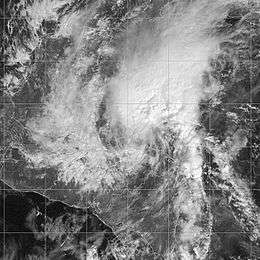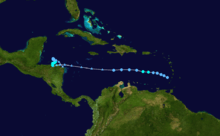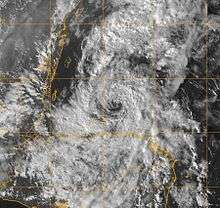Tropical Storm Gamma
| Tropical storm (SSHWS/NWS) | |
 Tropical Storm Gamma at peak intensity near Honduras on November 19 | |
| Formed | November 14, 2005 |
|---|---|
| Dissipated | November 22, 2005 |
| Highest winds |
1-minute sustained: 50 mph (85 km/h) |
| Lowest pressure | 1002 mbar (hPa); 29.59 inHg |
| Fatalities | 39 |
| Damage | $18 million (2005 USD) |
| Areas affected | Lesser Antilles, Honduras, Belize |
| Part of the 2005 Atlantic hurricane season | |
Tropical Storm Gamma was the 24th tropical storm of the 2005 Atlantic hurricane season. Gamma formed on November 18 from a tropical wave which had left the coast of Africa on November 3. Between November 13 and November 16 the system was designated Tropical Depression Twenty-Seven and moved westward through the Windward Islands into the Caribbean. Although its winds were not of tropical storm force, the storm brought damagingly heavy rainfall to Trinidad and to St. Vincent and the Grenadines.
On November 18, after a period of disorganization during which it appeared to be dissipating, the system strengthened and was upgraded to a tropical storm off the coast of Honduras and given the name Gamma. There, its torrential rainfall triggered deadly landslides. Gamma's winds and rains also reached into Belize, where they were less deadly. The storm dissipated on November 22, having killed 39 people.
Meteorological history

Tropical Storm Gamma originated out of a tropical wave that moved off the western coast of Africa on November 3.[1] For a late-season tropical wave, the system kept an unusually high amount of convection as it trekked across the Atlantic Ocean.[1] The National Hurricane Center (NHC) began to actively track the wave when it was located about 100 miles (160 km) off the coast of Barbados.[2] The low pressure area changed little during November 13, producing locally heavy rains in the Caribbean Islands, but not developing.[3] However upper-level shearing winds abated, making conditions conducive for tropical development,[3] and by November 14 the system had formed Tropical Depression Twenty-Seven.[4][5]
An upper-level trough near the Greater Antilles continued to provide westerly shear that briefly stalled the development,[5][6] but the system's strong convection persisted.[6][7] A break in the shear on November 15 enabled the storm to briefly strengthen. Post season analysis showed during this period the system reached tropical storm-status and should have been christened Gamma, but as this was not seen at the time, the storm remained classified Tropical Depression Twenty-Seven.[1] A deeplayered subtropical high pressure ridge over the southwestern Atlantic Ocean and Gulf of Mexico propelled the system westward across the Caribbean at more than 25 mph (40 km/h) and the storm's upper circulation was entirely separated from its deep convection and low level circulatory center.[1][8][9] The NHC, believing that the system was dissipating, announced that it was issuing its last advisory on November 16.[10] Soon after, the system slowed down on November 17.

A tropical wave, which had formed over Panama in early November and had produced rainfall in the region, merged into the waning remnants of Tropical Depression Twenty-Seven near Honduras on November 18. The system then restrengthened into a tropical storm on November 18 and was renamed Tropical Storm Gamma.[11] The system's strengthening was slow,[12] owing to the presence of high wind shear.[13] It reached peak winds of 50 mph (80 km/h)[1] before the shear exposed the center[14][15] and its weakening trend began.[16] Despite flares of convection,[16] Gamma weakened into a tropical depression on November 20[17] and further into a remnant low early on November 21.[1][18] The low quickly dissipated on November 22 near the Honduran-Nicaraguan border.[1]
Preparations
On November 18 the government of Honduras issued tropical storm warnings for the Bay Islands, Belize issued a tropical storm warning for its entire coast, and Mexico issued a tropical storm watch for the eastern Yucatán Peninsula from the Belize border to Punta Allen.[1][19] Before dawn the next day, as Gamma drew closer, Mexico modified the watch to a warning for its coast from the Belize border to Punta Gruesa, and expanded the tropical storm watch from Punta Gruesa to Tulum. That afternoon the storm moved away from Belize the southernmost portion of the tropical storm warning was lifted, followed in totality a few hours later.[1] That night, Mexico also lifted its watching and warnings. It was not until the following day, November 20, that the warnings were lifted from the Bay Islands of Honduras.[1]
Because the storm regenerated shortly before it was predicted to make landfall, few advanced preparations for the storm were taken in Honduras. However, constant rainfall for well over a day as Gamma wandered offshore caused floods that forced over 30,000 people to abandon their homes[20] for state-run shelters.[21]
Impact
| Country | Deaths |
|---|---|
| Belize | 3 |
| Honduras | 34 |
| St. Vincent | 2 |
| Totals | 39 |
Two people were killed by a mudslide in St. Vincent and the Grenadines on the island of Bequia[22] as Gamma's precursor, Tropical Depression 27, brought heavy rains. Overflowing rivers destroyed seven homes and make several roads impassable.[23] The island's airport was temporarily closed when the tropical depression flooded the terminal and left debris on the runway.[22][24] Heavy rains caused flooding and landslides, which washed away two bridges on the island of Trinidad, outside the capital Port-of-Spain.[22]
Although tropical storm-force winds did not impact mainland Honduras,[1] an unofficial report of 4.44 inches (113 mm) of rain was reported on Roatan Island,[1] and more than 30 inches (760 mm) of rain fell along the northern coast between November 16 and 19 before Gamma even reached the country.[25] The rainfall triggered flooding and landslides in the northern departments of Gracias a Dios, Colón, Atlántida, Cortés, Yoro, Santa Bárbara, and the Bay Islands which killed 34 people and left 13 missing .[20][25] These areas had already been affected by Hurricane Wilma and Hurricane Beta about a month earlier.[20] Dozens of bridges were washed away cutting off more than 50,000 people[26] and 2,000 homes were destroyed[20] 5,200 acres (21 km2) of banana crop was destroyed, totalling $13–18 million (2005 USD) in damage.[1]
In Belize, Gamma contributed to the crash of a private plane, operating from an exclusive jungle resort. All three people aboard were killed as it passed through Gamma's outer bands.[26] Five fishermen from Sarteneja were lost at sea during the storm when a large wave capsized their eight-man boat.[27]
Aftermath, naming, and records
The only country suffering lasting damage from the storm was Honduras.[28] After the storm turned out to sea and Gamma's rains desisted, Honduran helicopters began rescuing those stranded by flood waters.[28] The United Nations' World Food Programme spent $460,000 (2005 USD) airlifting 645 tonnes of food, enough for 195,000 five-person families, to northern Honduras.[29] The Red Cross also provided food aid, hygiene kits, blankets and other humanitarian aid to families that had sustained damage to their property or were displaced into shelters.[28] Both of these organizations already had active distribution networks in the country as they were responding to hurricanes Stan, Wilma, and Beta, all of which caused fatalities in Honduras that year.[29][30]
The government of Andalucía, in Spain, donated 40 million lempiras to aid in disaster efforts, and the United States employed helicopters from a nearby military base to assist Honduran ones in the distribution of food aid.[28][31] Relative to the hurricanes of previous weeks, the humanitarian needs following Gamma were minimal, and were simply blended into the ongoing efforts.[29] Following its usage, the name Gamma was not retired and will be used again when the regular list of names is exhausted.[32]
After all of the twenty one predetermined hurricane names for the 2005 season were exhausted following Hurricane Wilma, the Greek alphabet was used, beginning with Tropical Storm Alpha. This storm was designated Gamma once it was known to have reached tropical storm status.[11] This was the first time that the name Gamma had been used for a tropical cyclone.[33] Its formation extended the 2005 season's record for tropical storms to twenty-four, which was exceeded four more times and ended at twenty-eight storms after the formation of Tropical Storm Zeta and the post-season addition of an unnamed storm from October.[34]
See also
- Tropical cyclone
- List of 2005 Atlantic hurricane season storms
- Timeline of the 2005 Atlantic hurricane season
References
- 1 2 3 4 5 6 7 8 9 10 11 12 13 Stacy R. Stewart (2005-11-24). "Tropical Cyclone Report - Tropical Storm Gamma" (PDF). National Hurricane Center. Retrieved 2009-07-13.
- ↑ Knabb (2005-11-12). "Tropical Weather Outlook - November 12 - 10:30 PM". National Hurricane Center. Retrieved 2009-07-14.
- 1 2 Stewart (2005-11-13). "Tropical Weather Outlook - November 13 - 5:30 PM". National Hurricane Center. Retrieved 2009-07-14.
- ↑ Stewart (2005-11-13). "Tropical Weather Outlook - November 13 - 10:30 PM". National Hurricane Center. Retrieved 2009-07-14.
- 1 2 Stewart (2005-11-13). "Tropical Depression Twenty-Seven Discussion Number 1". National Hurricane Center. Retrieved 2009-07-14.
- 1 2 Pasch (2005-11-14). "Tropical Depression Twenty-Seven Discussion Number 2". National Hurricane Center. Retrieved 2009-07-14.
- ↑ Knabb (2005-11-14). "Tropical Depression Twenty-Seven Discussion Number 3". National Hurricane Center. Retrieved 2009-07-14.
- ↑ Knabb (2005-11-15). "Tropical Depression Twenty-Seven Discussion Number 8". National Hurricane Center. Retrieved 2009-07-14.
- ↑ Pasch (2005-11-16). "Tropical Depression Twenty-Seven Discussion Number 10". National Hurricane Center. Retrieved 2009-07-14.
- ↑ Beven (2005-11-16). "Tropical Depression Twenty-Seven Discussion Number 11". National Hurricane Center. Retrieved 2009-07-14.
- 1 2 Beven (2005-11-18). "Tropical Gamma Discussion Number 12". National Hurricane Center. Retrieved 2009-07-14.
- ↑ Beven (2005-11-19). "Tropical Depression Twenty-Seven Discussion Number 15". National Hurricane Center. Retrieved 2009-07-14.
- ↑ Knabb (2005-11-18). "Tropical Depression Twenty-Seven Discussion Number 13". National Hurricane Center. Retrieved 2009-07-14.
- ↑ Beven (2005-11-19). "Tropical Depression Twenty-Seven Discussion Number 16". National Hurricane Center. Retrieved 2009-07-14.
- ↑ Knabb (2005-11-19). "Tropical Depression Twenty-Seven Discussion Number 17". National Hurricane Center. Retrieved 2009-07-14.
- 1 2 Stewart (2005-11-20). "Tropical Depression Twenty-Seven Discussion Number 18". National Hurricane Center. Retrieved 2009-07-14.
- ↑ Stewart (2005-11-20). "Tropical Depression Twenty-Seven Discussion Number 19". National Hurricane Center. Retrieved 2009-07-14.
- ↑ Pasch (2005-11-20). "Tropical Depression Twenty-Seven Discussion Number 20". National Hurricane Center. Retrieved 2009-07-14.
- ↑ Staff Writer (2005-11-18). "Tropical storm Gamma forms in the Caribbean". Dominican Today. Archived from the original on 2012-02-23. Retrieved 2009-07-14.
- 1 2 3 4 Elizabeth Byrs (2006-11-30). "Honduras: Storm - OCHA-02: 30-Nov-05". Office for the Coordination of Humanitarian Affairs. Retrieved 2009-07-14.
- ↑ Stephen W Smith (2005-11-18). "Tropical Storm Gamma Forms". CBS Broadcasting Inc. Retrieved 2009-07-14.
- 1 2 3 Associated Press (2005-11-14). "Tropical depression kills two in Caribbean". USA Today. Retrieved 2009-07-14.
- ↑ From reports by The Palm Beach Post (2006). "Gamma recap". The Palm Beach Post. Retrieved 2009-07-14.
- ↑ AP (2005-11-16). "Tropical depression claims its first victims". Jamaica Observer. Retrieved 2009-07-14.
- 1 2 Staff Writers (2005-11-23). "Latin America and the Caribbean – Hurricane Season 2005" (PDF). U.S. Agency for International Development. Archived from the original (PDF) on 2009-07-24. Retrieved 2009-07-14.
- 1 2 Staff Writer (2005-11-21). "Honduras: Tropical Storm Gamma" (PDF). International Federation of Red Cross and Red Crescent Societies. Retrieved 2009-07-14.
- ↑ Angel Novelo (2005-11-25). "Five Sarteneja fishermen lost at sea! Believed blown south into Honduras". The Reporter. Retrieved 2009-07-14.
- 1 2 3 4 Staff Writer (2005-11-21). "Honduras: Tropical Storm Gamma Minor Emergency Bulletin No. 1". International Federation of Red Cross And Red Crescent Societies. Retrieved 2009-07-14.
- 1 2 3 Staff Writer (2005-11-23). "WFP feeds Honduran victims of Tropical Storm Gamma". World Food Programme. Retrieved 2009-07-14.
- ↑ Staff Writer (2005-11-23). "Hurricane season continues to batter Honduras". International Federation of Red Cross And Red Crescent Societies. Retrieved 2009-07-14.
- ↑ Government of Honduras (November 21, 2005). "Honduras: Ayuda internacional fluye con inmediatez" (in Spanish). ReliefWeb. Archived from the original on 2007-09-27. Retrieved 2006-07-13.
- ↑ Chris Vaccaro (2006-04-06). "DENNIS, KATRINA, RITA, STAN AND WILMA "RETIRED" FROM LIST OF STORM NAMES - International Committee Selects Replacement Names for 2011 List". National Oceanic and Atmospheric Administration. Retrieved 2009-07-14.
- ↑ Jon Hamilton (2005-11-29). "Busiest Hurricane Season Ends with New Storm". npr. Retrieved 2009-07-14.
- ↑ Stewart, Beven, Avila, Franklin, Knabb, Pasch, and Blake (2007-01-23). "Tropical Weather Summary - 2005 Web Final". National Hurricane Center. Retrieved 2009-07-14.
External links
- The NHC's archive on Tropical Storm Gamma.
- Yahoo! News story
